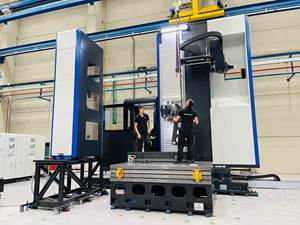Using Hard Turning To Reduce Grinding Time
A machine tool builder found that by hard turning its lathe spindle shafts extremely close to net shape, it could cut grinding time in half.
Share



For certain applications, hard turning can deliver tolerances and surface finishes that make grinding unnecessary. For extremely tight-toleranced jobs, hard turning can also serve as an effective pre-finishing operation. Machining a hardened part to within a few thousands of an inch of net shape speeds grinding by minimizing the amount of material that has to be removed.
That's precisely why Haas Automation's manufacturing facility in Oxnard, California, now hard turns its lathe spindle shafts prior to finish grinding. The company hard turns a variety of other machine components to final size and surface finish specifications, but this is the first time it has used hard turning as a pre-finishing operation. Not only has this made ID and OD grinding quicker, but it has also eliminated an interrupted grinding situation that resulted because of shaft surface distortion after heat treatment.
Distortion Dilemma
The company's move to integrate hard turning into its spindle shaft manufacturing process was spurred by the surface distortion problem. The unpredictable distortion made it difficult to accurately locate the inner and outer shaft diameters, which meant the grinding operations had to be set up for the worst case scenario (largest OD, smallest ID) in order to first knock down material high spots. Not only did this increase the number of passes required, but it also created a condition of interrupted grinding, which adversely affected wheel life.
Haas stocks one of its SL-40L CNC lathes with cubic boron nitride (CBN) inserts to turn the mid-50s Rc spindle shafts prior to grinding. The machine takes one pass each for inner and outer diameters with up to a 0.015-inch depth of cut. "Our hard turning process can deliver diameter tolerances of ±0.0003 inch, but requirements for the pre-finishing operation on the spindle shafts are not as tight," says Don Teller, Haas tooling manager. The cut takes the shaft diameters to between 0.003 to 0.005 inch of finish size, which reduces grinding time by 50 percent and extends wheel life.
The company does not use coolant when machining the spindle shafts. That's because the relatively deep depth of cut (DOC) creates a chip that is large enough to take out the majority of the heat generated by the cut, which is the objective in hard turning. When hard turning parts with critical tolerances at very small DOCs, however, the company floods the cutting zone with coolant. "In cases where the cutting depths are very small, the chip lacks the mass to carry out the heat that a larger chip would," says Mr. Teller. "Because additional heat is directed into the part, we use a high volume of coolant to maintain thermal stability and hold tolerances."
Such fine chips also have a tendency to "steel wool" around the tool tip, so flooding the cutting zone allows sufficient coolant to pass through the chips and reach the tool tip. "When OD hard turning, it is also helpful to deliver the coolant from opposite directions, if possible, in case chip wrapping occurs," says Mr. Teller. "High pressure coolant is another alternative, but you have to be precise in directing the coolant to the tool tip."
Related Content
A History of Precision: The Invention and Evolution of Swiss-Style Machining
In the late 1800s, a new technology — Swiss-type machines — emerged to serve Switzerland’s growing watchmaking industry. Today, Swiss-machined parts are ubiquitous, and there’s a good reason for that: No other machining technology can produce tiny, complex components more efficiently or at higher quality.
Read MoreAddressing Manufacturing Challenges with Automation
GrayMatter Robotics’ Physical AI robotic cells for manufacturing offer immediate impact and results.
Read MoreControlling Extreme Cutting Conditions in Large-Part Machining
Newly patented technologies for controlling chatter and vibration during milling, turning and boring operations promise to drastically reduce production time and increase machining performance.
Read MoreHow to Determine the Currently Active Work Offset Number
Determining the currently active work offset number is practical when the program zero point is changing between workpieces in a production run.
Read MoreRead Next
OEM Tour Video: Lean Manufacturing for Measurement and Metrology
How can a facility that requires manual work for some long-standing parts be made more efficient? Join us as we look inside The L. S. Starrett Company’s headquarters in Athol, Massachusetts, and see how this long-established OEM is updating its processes.
Read More














 (1).png;maxWidth=300;quality=90)
-02.jpg;maxWidth=300;quality=90)










